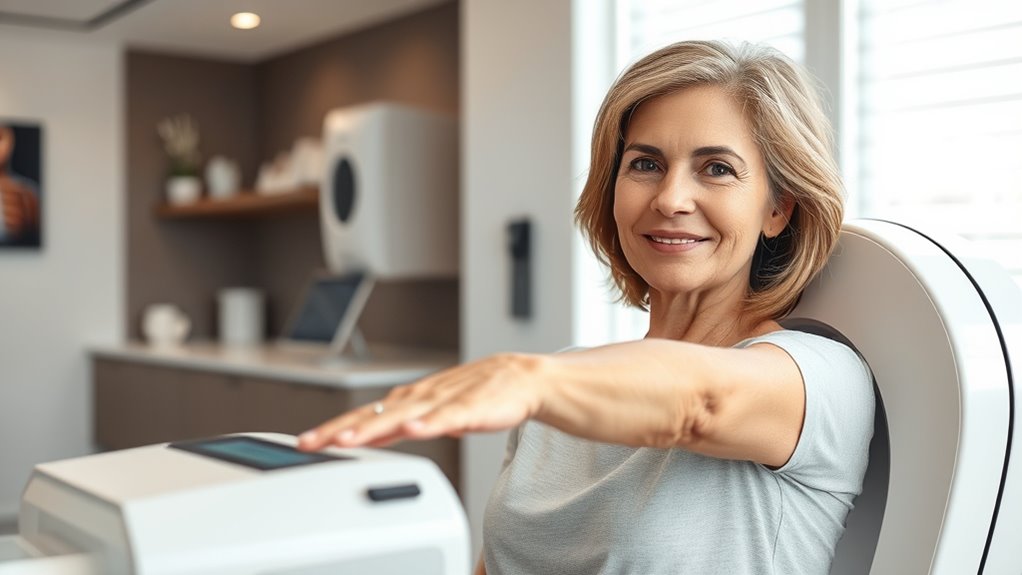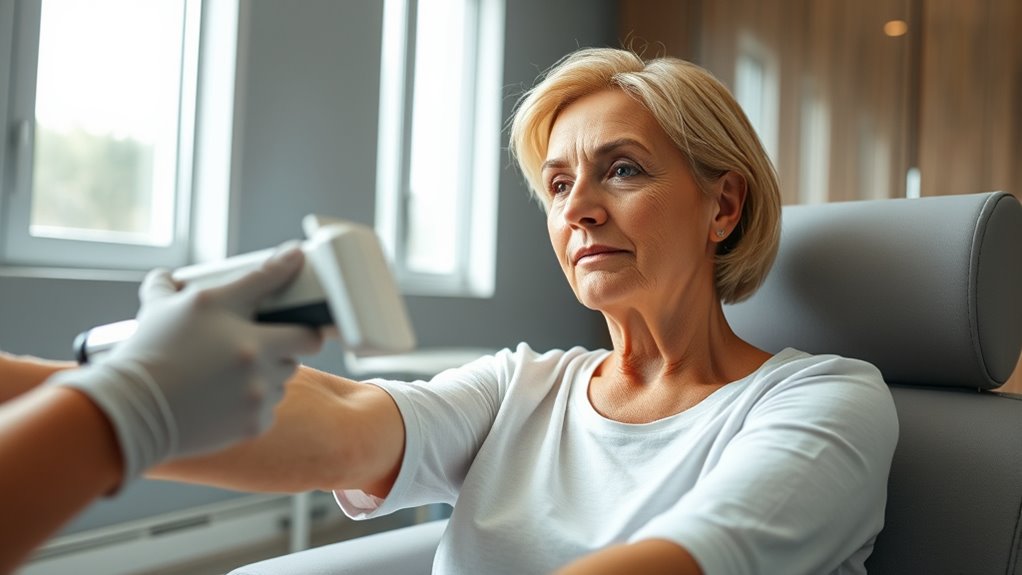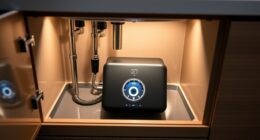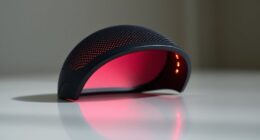If you’re a midlife woman, bone density testing helps you assess your risk of osteoporosis and fractures. The test is quick, painless, and involves a simple scan of your hips and spine. It shows whether your bones are healthy or if you need to make lifestyle changes or medication efforts. Staying proactive about bone health is essential. To learn more about preparing for the test and next steps, keep exploring the key details.
Key Takeaways
- Bone density testing measures mineral content to assess fracture risk in midlife women, especially postmenopausal individuals.
- The test is quick, painless, and involves low-dose X-rays of the hips and spine.
- Women over 50 or with risk factors should consider screening to detect osteoporosis early.
- Results help guide lifestyle changes or treatments to strengthen bones and prevent fractures.
- Regular testing is recommended for high-risk women to monitor bone health over time.
Understanding Bone Density and Its Importance

Bone density refers to the amount of mineral content in your bones, which directly affects their strength and stability. When your bone density is high, your bones are more resistant to fractures. Conversely, low bone density means your bones can become fragile and more prone to breaks. As you age, especially during midlife, your bone density naturally decreases due to changes in hormones and other factors. This decline can lead to conditions like osteoporosis, where bones become weak and brittle. Understanding your bone density helps you recognize the importance of maintaining strong bones through proper nutrition, exercise, and lifestyle choices. Keeping your bones healthy is essential for staying active, avoiding injuries, and preserving your independence as you age. Regular bone density testing can help detect early signs of decline and guide preventative measures.
Who Should Consider Getting Tested

Knowing your bone density can help you take proactive steps to protect your health, especially if you’re at higher risk for conditions like osteoporosis. You should consider testing if you:
- Are a woman over age 50 or postmenopausal
- Have a family history of osteoporosis or fractures
- Have experienced a fracture after minor trauma
- Have lifestyle factors like smoking, excessive alcohol, or low calcium intake
Additionally, if you have conditions such as rheumatoid arthritis or thyroid disorders, testing is advisable. Women who are on certain medications like corticosteroids should also consider bone density tests. If you’re unsure whether you fall into these categories, consult your healthcare provider. Early detection can help you make informed decisions to maintain strong bones and prevent fractures. Regular bone density testing can be an essential part of proactive health management.
The Procedure: What to Expect During the Test

During a bone density test, you’ll lie comfortably on a table while a specialized scanner passes over your body, typically targeting your hip and spine. The procedure is quick and painless, lasting about 10 to 30 minutes. You won’t need to remove clothing or wear a gown, but you may be asked to change into a gown if your clothing contains metal. During the scan, you’ll lie still as the scanner emits low-dose X-rays that measure bone density. The process is completely non-invasive, with no injections or anesthesia involved. You might feel a slight pressure from the scanner, but there’s no discomfort or pain. A key aspect of the test is its use of non-invasive imaging technology, ensuring safety and ease for the patient. Afterward, you can go about your day as usual, with no recovery time needed.
Interpreting Bone Density Results and Next Steps

After your bone density test, the technician will analyze the scan results to determine your bone health status. They’ll look at your T-score, which compares your bone density to that of a healthy young adult. Based on this, your results may indicate:
- Normal bone density, meaning your risk of fracture is low.
- Osteopenia, a borderline condition that suggests moderate bone loss.
- Osteoporosis, indicating significant bone loss and higher fracture risk.
- Severe osteoporosis, where bone loss is advanced, increasing fracture chances further.
Your healthcare provider will review these results with you, explain what they mean for your health, and discuss potential next steps. This might include lifestyle adjustments, medications, or further testing to protect your bones. Data analytics can also help monitor your progress over time and tailor your treatment plan accordingly.
Lifestyle Changes and Preventive Measures for Strong Bones

To help keep your bones strong and reduce the risk of fractures, adopting healthy lifestyle habits is essential. You can boost your bone health by making simple changes daily. Regular weight-bearing exercise, like walking or dancing, stimulates bone growth. Eating a balanced diet rich in calcium and vitamin D supports bone strength. Avoid smoking and limit alcohol intake, as both weaken bones over time. Additionally, managing your overall health through proper sleep and stress reduction helps maintain bone density. Here’s a quick overview:
| Activity | Nutrition | Habits |
|---|---|---|
| Weight-bearing exercise | Calcium-rich foods | No smoking |
| Resistance training | Vitamin D sources | Limit alcohol consumption |
| Walking or dancing | Leafy greens, dairy | Regular health checkups |
| Jogging | Fortified foods | Adequate sleep |
| Yoga or stretching | Supplements if needed | Stress management |
Maintaining awareness of bone health can motivate you to stay consistent with these habits.
Frequently Asked Questions
How Often Should I Have a Bone Density Test?
You might wonder how often you should get a bone density test. Typically, if you’re at average risk, every two years is recommended. However, your doctor might suggest more frequent testing if you have risk factors like a family history of osteoporosis or previous fractures. It’s important to follow your healthcare provider’s advice, as they’ll tailor the schedule to your specific health needs and risk factors.
Are There Any Risks Associated With Bone Density Testing?
Did you know that bone density tests involve minimal radiation exposure, similar to a chest X-ray? Generally, the risks are low, but some people might experience minor discomfort from the placement of the scanner or a slight allergic reaction to contrast agents. You should talk to your doctor if you’re pregnant or have other health concerns. Overall, the benefits of detecting osteoporosis early usually outweigh the small risks involved.
Can Diet Alone Improve My Bone Density Scores?
You wonder if diet alone can boost your bone density scores. While eating calcium-rich foods like dairy, leafy greens, and fortified products helps support bone health, it might not be enough by itself. Combining a balanced diet with weight-bearing exercises, adequate vitamin D, and lifestyle changes offers a more effective approach. Consult your healthcare provider to develop a personalized plan that best suits your needs and improves your bone strength.
How Does Menopause Impact Bone Density?
Did you know that after menopause, women can lose up to 20% of their bone density in just 5-7 years? Menopause markedly impacts your bone health because your estrogen levels drop, leading to increased bone breakdown. This makes your bones weaker and more prone to fractures. To protect yourself, consider lifestyle changes, calcium, vitamin D intake, and regular screening. Staying proactive helps maintain stronger bones during this progression.
Is Bone Density Testing Covered by Insurance?
You might wonder if insurance covers bone density testing. Coverage varies depending on your plan and the reason for testing. Typically, if your doctor recommends it due to risk factors like menopause or fractures, insurance often covers part or all of the cost. Check with your provider beforehand to confirm what’s included. Knowing your coverage helps you plan and guarantees you get the testing you need without unexpected expenses.
Conclusion
So, you’ve got your bone density test—great! Now, just sit back and wait for your bones to tell you whether they’re strong enough to support your daily adventures or if they’re secretly plotting a break. Remember, ignoring these numbers is almost as wise as ignoring a crumbling bridge. Stay proactive, make those lifestyle tweaks, and keep your skeleton happy—because nobody wants a surprise visit from the broken bone club.









